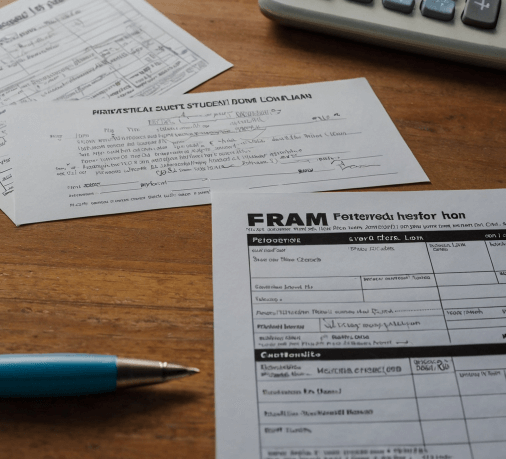Making Sense of Student Loan Options
Deciding how to pay for college is confusing. With federal and private loans, grants, scholarships, and family contributions – how do you know what’s best? I’m here to break down the pros and cons so you can make the choice that works for your situation.
Federal vs Private: The Basics
The first thing to understand is that federal and private loans come from different sources.
Federal Student Loans
Federal student loans come from the U.S. Department of Education. Options include:
- Direct Subsidized Loans: The government pays the interest while you’re in school. These are need-based.
- Direct Unsubsidized Loans: You pay all the interest, although you can defer payments. These are non need-based.
- PLUS Loans: Higher limit loans for graduate students, professionals, and parents. Interest accrues during all periods.
The main perks of federal loans are fixed interest rates, flexible repayment plans, and forgiveness programs. Interest rates for 2023-2024 range from 4.99% to 7.32%.
Private Student Loans
Private student loans come from banks, credit unions, state agencies and other lenders. These feature variable rates based on financial health, from less than a percent for exceptional credit ratings to over 12% for poor scores. Private loans lack flexible repayment and forgiveness options.
As you can see, federal and private loans have significant differences! Now let’s talk more in-depth.
Interest Rates and Terms Matter
Federal loans have fixed rates between 4.99% and 7.32% for the 2023-2024 academic year. This rate remains the same through repayment unless you consolidate or refinance. As of early 2023 the average private loan range is 4% to over 12%. Get specific rates from your lender – anything under 6% is ideal. Even small percentage differences add up with student debt!
Loan terms are another major facet. Federal loans can extend 10 to 25 years. Private loans often expect full payment in 5 to 15 years. Choose federal loans for more wiggle room, most borrowers need it! Be realistic about your future income before picking private financing with strict time constraints around repayment.
Repayment Perk: Flexibility
Now we get to the good stuff – those flexible federal repayment options!
Income-Driven Repayment Plans
Federal loans allow income-driven repayment. Monthly payments scale to your salary after college. Losing your job? Payment amount can readjust down. Options like Pay As You Earn (PAYE) and Revised Pay As You Earn (REPAYE) require payments equal to only 10% of discretionary income.
After 20 or 25 years of payments, any remaining balance is forgiven (but taxed as income then). Private lenders don’t offer this route. Unless you’ll have an exceptional post-grad salary, strongly consider federal over private.
Deferment and Forbearance
Federal loans allow deferment and forbearance. Deferment means no payments due with interest frozen for up to three years. Great if pursuing full-time graduate studies. Forbearance similarly suspends payments, however interest racks up! Still, very useful if facing illness or unemployment.
Private student loans rarely match this flexibility. You must continuously make payments no matter the life challenges tossed your way. So I would lock-in federal funding FIRST whenever possible!
The Power of Federal Forgiveness Plans
Federal forgiveness plans are seriously incredible, I wish more people knew how amazing they are! Let me tell you all about them:
Public Service Loan Forgiveness
PSLF forgives federal loan balances after 10 years of payments while working at an eligible nonprofit or public service employer. Any remaining amount discharged tax-free! Police, military personnel, teachers, medical professionals, librarians, public defenders, and government employees benefit most.
To receive forgiveness after 10 years, loans must enter income-driven repayment plans at the start of public service work. Payments count even if super low like $20 a month based on earnings. At the decade mark, poof goes the debt! Sweet deal if public service aligns with your career aspirations.
Teacher Loan Forgiveness
TFL helps educators in low-income Title I schools. $5,000-$17,500 can be forgiven on federal subsidized and unsubsidized loans. Teaching full-time for 5 consecutive years required. Combining TFL with PSLF allows more loan cancellation. Teachers get double forgiveness! Check specific qualifications.
As you can see, federal loans open pathways to eventual freedom from student debt, especially for graduates entering public service fields. Private loans simply lack this benefit.
Applying for Aid and Loans
Alright, let’s discuss how to get approved and receive funding. Both federal and private loan eligibility depend heavily on history.
Federal Loan Requirements
Only students attending an accredited and Title IV eligible university can receive federal loans. Other key needs:
- FAFSA – Free Application for Federal Student Aid. This lengthy form documents finances and family info for aid approval.
- Citizenship Verification: Only U.S. citizens, legal permanent residents and refugees can gain federal assistance.
- Satisfactory Academic Progress: Students must reasonably progress towards graduation requirements quarter to quarter and year over year. Dropping too many classes or flunking multiple terms leads to ineligibility if not corrected.
- Selective Service Registration: Male students 18 and older must register with the Selective Service. Failure to register, even accidentally, cuts federal access. Quick and easy info to supply.
- Default Resolution: Past problems with federal loans blocking approval? Contact loan servicers immediately to discuss options like rehabilitation and consolidation to regain eligibility. Don’t wait!
Submit documents early, communicate with the financial aid office for help, and stay on top of records to keep funds flowing semester to semester.
Private Loan Qualifications
Private student lenders approve applications based mainly on:
- Credit History and Ratings: Federal loans don’t require stellar credit or previous borrowing experience. In contrast, private lenders deeply investigate your score and reports pulling from the three credit bureaus. Income sources, existing debts, and payment history influence the interest rates offered. Those with little independent credit exposure may need a creditworthy cosigner for approval. Fix errors on reports wisely and rapidly. Pay all current debts on-time! Your credit past and present make or break private options.
- Debt-to-Income Ratio Metrics: Lenders measure total recurring debts against reliable monthly income looking for sufficient leftover funds to handle this additional obligation. Controlling other borrowing commitments while in school – like credit cards, car financing, previous education debt, etc allows more favorable private terms. Live frugally as possible and minimize unnecessary burdens weighing down this ratio.
- Relationship History: Banks extend preferential rates and easier approvals to long-term clients holding assets internally. Having an established account since childhood may provide leverage! Acquire private funding from institutions you personally do business with already.
As you can see, private lenders evaluate borrowers much more critically than federal options. Plan years ahead to craft ideal conditions for approval.
Which Student Loan Is Best for You?
We covered so much information! Let’s summarize key takeaways:
- Federal student loans have fixed interest rates between 4.99% and 7.32%. Private loans fluctuate between less than 2% up to 12% based on individual credit variables.
- Federal loans offer income-driven repayment plans with forgiveness of remaining balances after 20 or 25 years of payments. Private loans have fixed monthly payments and rigid 5-15 year terms.
- Those pursuing Public Service Loan Forgiveness or Teacher Loan Forgiveness immediately benefit more from federal options. Certain careers allow federal forgiveness in as little as 10 years.
- Federal loans depend on basic eligibility factors like citizenship, academic progress, Selective Service status, and resolved previous defaults. Private loans require robust credit history and income metrics for approval. Unique advantages exist on both sides!
Evaluate your field of study, earning potential after graduation, career goals in the public or private sectors and personal financial management competencies. With clear insights into these areas, decide if flexible low-interest federal loans or variable-rate private loans with stricter terms best align with your needs.
Reach out for help! I’m always available to discuss more and assist with narrowing your student loan search. Which programs look most useful? Let’s sign you up to invest in your education while responsibly building credit. Excited to guide you on this journey!






Leave a Reply